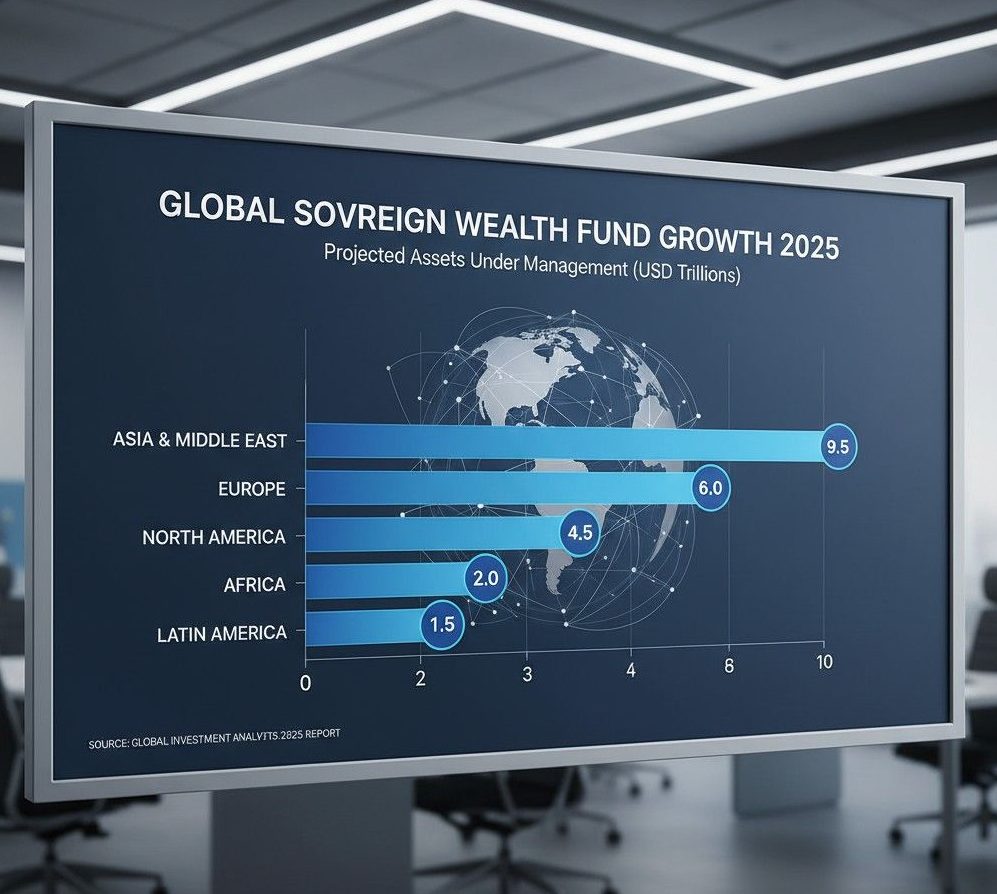The Expanding Role of Sovereign Wealth Funds in 2025
Sovereign wealth funds are no longer quiet financial vehicles in 2025. These state-backed investment funds now control more than 12 trillion dollars in assets. Their reach extends from Wall Street to Asian tech hubs, from African infrastructure projects to European real estate. Policymakers, investors, and corporations must watch them closely. The power shift they represent is shaping how global markets allocate capital and manage risks.
Core Functions and Global Significance
Definition and Origins of Sovereign Wealth Funds
Sovereign wealth funds are state-owned investment funds created to manage excess capital. Governments build them using surpluses from trade, energy exports, or reserves. The Norway sovereign wealth fund, for example, grew from oil revenues and became a model of disciplined, transparent investing. Over time, sovereign wealth turned into an institutional force, balancing domestic stability with global exposure.
2025 as a Year of Transformation
Sovereign wealth funds 2025 look different from their predecessors. They are more aggressive, diversified, and politically significant. Traditional portfolios focused on bonds and public equities have expanded. Now, sovereign funds drive investments in green energy, digital infrastructure, and private markets. This shift reflects both national interests and global economic changes. The outcome is a capital force more influential than many global banks.
Regional Breakdown of Sovereign Wealth Funds
Europe’s Model of Stability: Norway and Beyond
The Norway pension sovereign fund remains the world’s largest. It manages over 1.5 trillion dollars with strict governance. Its disciplined approach sets standards in ESG and long-term planning. Other European sovereign funds, though smaller, emphasize transparency and low-risk diversification. Europe uses these funds as stabilizers rather than aggressive growth vehicles.
Middle East Giants: Saudi Arabia PIF and UAE ADIA
The Saudi Arabia sovereign wealth fund PIF stands as the fastest growing. It targets 2 trillion dollars in assets by 2030. In 2025, the PIF invests heavily in sports, tourism, and renewable energy as part of the Saudi Vision 2030 strategy. The UAE ADIA sovereign wealth maintains a more traditional, diversified global approach. Together, Middle Eastern funds redefine how oil-rich states convert resource wealth into global influence.
Asia’s Heavyweights: Singapore GIC, China CIC, Japan GPIF
Asia commands an increasingly dominant share of sovereign wealth. The Singapore GIC fund leads in private equity, tech, and global real estate. The China sovereign wealth CIC focuses on strategic sectors aligned with Beijing’s industrial policy. Japan GPIF sovereign capital emphasizes pensions but also integrates ESG principles. Asia’s sovereign funds act as both national safety nets and engines of global capital expansion.
New Entrants: India and Africa’s Growing Funds
India’s sovereign investment fund is emerging as a tool for infrastructure financing and attracting foreign partnerships. Africa’s new funds, fueled by natural resource revenues, play smaller roles but are gaining importance. These funds may lack scale today but point to a future of more diverse state capital flows.
Capital Deployment and Investment Reach
Influence in Global Equity and Debt Markets
Sovereign wealth funds act as long-term stabilizers in equity and debt markets. They absorb volatility during crises and provide patient capital.

Their presence affects valuations of blue-chip companies, government bonds, and corporate debt. Investors cannot ignore sovereign flows when assessing market sentiment.
Expansion into Private Equity and Venture Capital
Sovereign wealth in private equity is now mainstream. Funds like Singapore GIC and Saudi PIF allocate billions to startups and growth-stage companies. Their entrance raises competition for private equity firms. Sovereign-backed investments in venture capital are funding the next generation of global leaders in fintech, biotech, and energy.
Infrastructure and Renewable Energy Commitments
Infrastructure investments SWF are rising. Roads, ports, airports, and digital infrastructure attract long-term sovereign capital. Green energy sovereign wealth funds focus on solar, wind, and hydrogen projects. This reflects both environmental commitments and the need for stable, inflation-protected returns.
Political and Strategic Dimensions
Sovereign Funds as Foreign Policy Tools
Governments use sovereign funds to advance foreign policy. Acquiring stakes in critical technologies or energy assets can align with strategic goals. The geopolitics of sovereign wealth plays out in competition for resources, influence in global companies, and soft power projection.
Challenging Wall Street and Western Financial Institutions
Global sovereign funds now compete with traditional Western institutions. Their capital allows them to bypass investment banks and asset managers. They negotiate deals directly and set terms. This reduces the dominance of Wall Street in global finance and creates multipolar competition.
Market Risks of State-Controlled Investments
State-backed investment funds can introduce distortions. Political priorities may override commercial logic. Concentrated positions in strategic sectors can amplify market risks. Investors must factor in both financial and political motivations when assessing sovereign capital flows.
Driving Innovation and Sectoral Shifts
Funding the Next Wave of Technology
Sovereign wealth funds in tech investments 2025 are more aggressive. They provide capital for artificial intelligence, cloud infrastructure, and quantum computing. These investments aim to secure leadership in emerging technologies critical for national competitiveness.
Growing Exposure to AI, Fintech, and Biotech
Sovereign funds target high-growth industries. AI, fintech, and biotech attract steady capital flows. This is not just about returns but also about shaping future economic landscapes. National governments see these sectors as essential to future resilience.
Supporting Startups With Strategic Capital
Sovereign wealth capital in startups provides patient funding that private investors cannot always match. Startups benefit from stable backing and international expansion opportunities. This capital flow helps sovereign funds gain influence in innovation ecosystems worldwide.
Implications for Global Investors
How to Monitor Sovereign Wealth Activity
Investors must track sovereign fund investments through filings, partnerships, and government announcements. Monitoring flows gives insight into long-term trends that affect sectors and geographies.
Aligning Portfolios With SWF Priorities
Aligning portfolios with sovereign funds can generate opportunities. When global sovereign funds prioritize green finance or infrastructure, investors can follow these flows to anticipate growth.
Risks Hidden in State-Led Strategies
Investors must also manage risks. State-backed decisions may change suddenly due to politics. Exposure to sectors favored by sovereign wealth funds can amplify volatility if strategies shift.
Accountability and Governance Concerns
The Ongoing Transparency Problem
Despite progress, many sovereign wealth funds still lack transparency. Details about allocations, governance, and returns are often limited. This creates uncertainty for global markets.
Efforts to Standardize Disclosure Practices
Institutions like the International Forum of Sovereign Wealth Funds push for disclosure standards. Some progress is visible, but practices remain inconsistent. Stronger reporting would build confidence in sovereign-backed capital flows.
Building Confidence in Sovereign Capital
Transparency and accountability are critical for trust. Investors and policymakers need reliable data to integrate sovereign flows into strategies. Confidence in governance will shape the role of these funds in future global markets.
Looking Ahead to 2030 and Beyond
Growth Outlook for Global Sovereign Funds
By 2030, assets under management may exceed 15 trillion dollars. Growth will depend on energy revenues, export surpluses, and investment performance. Sovereign funds will continue to shape global markets as their scale expands.
Green Finance and Net-Zero Commitments
Sovereign wealth funds and green finance 2025 highlight the shift to sustainability. Many funds now commit to net-zero targets. This aligns state-backed investment strategies with climate goals.
Role in Financing Emerging Market Development
Emerging markets depend increasingly on sovereign-backed infrastructure finance. State capital can fill gaps left by private investors. Sovereign funds will likely remain key partners in regional development projects.
Guidance for Policymakers and Market Participants
Tracking and Regulating Sovereign Flows
Policymakers must track sovereign flows carefully. Monitoring helps manage systemic risks and prevents undue influence. Regulation should balance openness with security concerns.
Balancing Geopolitical Tensions in Finance
Global sovereign funds bring both cooperation and competition. Balancing geopolitical tensions in finance requires clear frameworks. Collaboration on infrastructure and climate can offset rivalry in strategic sectors.
Positioning Investment Strategies for the Future
Market participants should position portfolios with sovereign strategies in mind. Sectors favored by state capital will enjoy long-term support. Investors who align early can benefit from sovereign-driven momentum.
Common Questions About Sovereign Wealth Funds
What defines a sovereign wealth fund?
A sovereign wealth fund is a state-owned investment fund. It manages reserves or surpluses for long-term returns and stability.
Which countries manage the largest funds today?
Norway, Saudi Arabia, UAE, China, and Singapore manage the largest funds. Together, they represent over half of global sovereign wealth.
How do sovereign wealth funds influence financial markets?
They influence markets through long-term investments, countercyclical strategies, and sectoral bets. Their size makes them unavoidable players.
What sectors are the top priorities in 2025?
Technology, renewable energy, infrastructure, and healthcare dominate 2025 priorities. These sectors align with both returns and national strategies.
Final Thoughts: The Global Market Impact of Sovereign Wealth Funds in 2025
Sovereign wealth funds 2025 stand as powerful actors in global markets. Their trillions in assets shape equity, debt, infrastructure, and innovation.

They act as stabilizers, investors, and geopolitical tools. Their rise changes the balance of global finance. For investors and policymakers, ignoring them is no longer an option. Educational purposes only, not financial advice.
